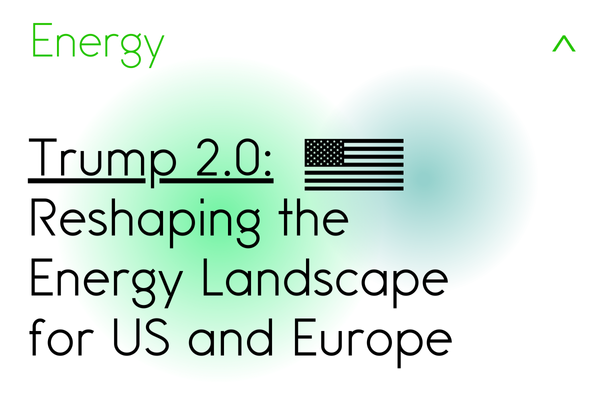Trump 2.0: Reshaping the Energy Landscape for US and Europe
06 Nov, 20242minsThe US Networks have just called the election for Donald Trump. As he prepares to retu...

The US Networks have just called the election for Donald Trump. As he prepares to return to the White House, global energy markets face a period of potential transformation. The intersection of geopolitics, energy security, and economic policies under Trump's second term could reshape not only America's energy landscape but also its critical relationship with European partners. While campaign rhetoric often differs from governing reality, several key factors suggest significant changes ahead for global energy dynamics.
The LNG Connection: A Cornerstone of Transatlantic Energy Relations
The most stable element in this shifting landscape appears to be America's role as Europe's key LNG supplier. Since Russia's invasion of Ukraine nearly three years ago, the United States has emerged as Europe's energy lifeline, providing approximately 48% of the EU's LNG imports. This relationship, born of necessity and nurtured by mutual interests, transcends political divisions.
What makes this partnership particularly resilient is its foundation in market economics rather than purely political considerations. As industry analyst Tom Marzec-Manser notes, "There's no decision that a new president could conceivably make on LNG that would mean much for European energy markets this winter or next." The infrastructure is in place, contracts are signed, and both sides have too much at stake to disrupt this vital energy link.
Trade Policies and Energy Market Dynamics
However, Trump's proposed trade policies could introduce new complexities into the energy relationship. His campaign has outlined plans for broad tariffs – at least 20% on all imports and potentially up to 60% on Chinese goods. These policies, while aimed at promoting domestic manufacturing, could create ripple effects throughout the energy sector.
The American Petroleum Institute, traditionally supportive of Republican energy policies, has expressed concerns about these tariff proposals. As their spokesperson Justin Prendergast explains, "The overly broad use of tariffs can have serious unintended consequences for US consumers and businesses." The impact could be particularly pronounced for refineries that rely on specific grades of imported crude oil, potentially leading to higher gasoline prices for American consumers.
The China Challenge: A Tale of Two Energy Giants
The US-China energy rivalry adds another layer of complexity to the global energy landscape. While Trump has criticized China's continued coal plant development – approximately one new plant per week in 2023 – the reality is more nuanced. China has simultaneously emerged as the world's leading investor in renewable energy, installing an impressive 195 GW of solar and wind power in just the first nine months of 2024.
This dual strategy by China presents both challenges and opportunities for US energy policy. Under Trump's leadership, America might focus more intensively on traditional energy sources, potentially ceding ground in the rapidly growing clean energy manufacturing sector. However, this could also spur domestic innovation and competition in conventional energy technologies where the US maintains significant advantages.
Ukraine Conflict: A Shifting Energy Security Paradigm
The potential restructuring of US support for Ukraine under Trump could have far-reaching implications for European energy security. The past three years have seen a dramatic reorganization of European energy supplies, with the continent rapidly pivoting away from Russian dependence. Any significant policy shifts regarding Ukraine could force Europe to once again revaluate its energy security strategy.
European officials are already preparing for various scenarios. The continent has demonstrated remarkable adaptability in diversifying its energy sources, but questions remain about long-term supply security. The development of new LNG terminals and pipeline routes may take on renewed urgency as Europe seeks to maintain its energy independence regardless of geopolitical shifts.
Market Implications and Industry Response
The energy sector is likely to see substantial changes in investment patterns and market dynamics. While Trump's policies may favour traditional energy sources, market forces and existing clean energy investments will continue to shape industry development. The Inflation Reduction Act has already spurred over $110 billion in clean energy manufacturing investments, creating an estimated 170,000 jobs – momentum that would be difficult to completely reverse.
Industry leaders are preparing for a complex balancing act. Oil and gas companies may see expanded opportunities for domestic production and exports, but they'll also need to navigate potential supply chain disruptions from new trade policies. Meanwhile, renewable energy companies may face a less supportive federal policy environment while still benefiting from state-level initiatives and declining technology costs.
Looking Forward: Navigation Through Uncertainty
As the energy sector prepares for Trump's return to office, several key factors will determine the actual impact of policy changes. Implementation timelines, international responses, market adaptation, and technological advancement will all play crucial roles in shaping the future energy landscape.
The relationship between US and European energy markets will likely remain strong, even as it adapts to new political realities. Both regions have too much invested in their energy partnership to allow it to fragment, even as they navigate new challenges and opportunities in the global energy marketplace.
What emerges from this transition period may be a hybrid energy landscape – one that continues to leverage America's traditional energy strengths while adapting to the inexorable march of technological progress and market evolution. For both US and European stakeholders, success will lie in finding balanced approaches that ensure energy security while remaining responsive to market demands and economic realities.


